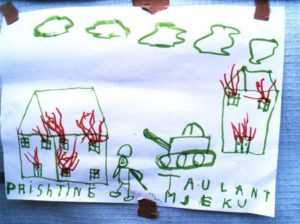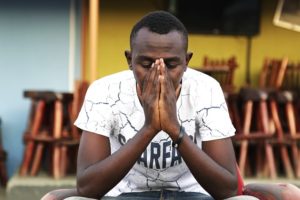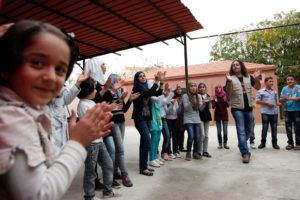
This systematic review into psychosocial interventions for adult refugees (Tribe et al, 2017) is covering an increasingly important area.
The numbers forced to leave their homes as a result of organised violence are higher now than any time since the second world war (UNHCR, 2017). There are approximately 60 million displaced people in the world, of whom 22 million are currently refugees (having crossed an international border).
Epidemiological data consistently highlights the increased prevalence of mental health difficulties in refugee populations (see Mina’s previous blogs), although refugee populations are highly heterogenous having experienced a considerable range of different experiences and then, through various means of travel and exposures to insecurity, settle (either temporality or permanently) in a range of different post-migration contexts. The studies have thus far clearly highlighted the combined influences of exposure to previous traumatic events and post-migration stressors as having the greatest impact on mental health outcomes (Miller et al, 2010).

Worldwide, the number of people forced to leave their homes as a result of organised violence are higher now than any time since the second world war.
Methods
This review took a broad selection of intervention studies primarily investigating post-traumatic stress disorder (PTSD) although they included depression and anxiety in the outcomes of interest, yet these disorders were not included in their search terms. They searched four databases and only included English language studies.
They included clinic samples as well as RCTs of general population samples and to ensure as much data as possible was included, only studies with less than 10 participants were excluded.
Results
Of the 5,300 articles that were screened, 40 studies were included. These are presented in a table as well as described according to intervention type.
Narrative Exposure Therapy (NET) was the most empirically supported intervention and has been studied using lay counsellors as well as mental health professionals, providing an indication as to its potential scalability (Robjant et al, 2010). It is usually given in around 6-10 treatment sessions with a study reporting few sustained effects of brief (3 session) NET on refugees experiencing multiple traumatic events.
Eye Movement Desensitisation and Reprocessing (EMDR) had some data with limited overall evidence as 2 RCTs reported effectiveness and 2 reported no effects.
Culturally sensitive CBT was reported to be studied with good effects by one team in a clinic setting and standard CBT was studied in 2 RCTs with limited evidence to support its use.
A range of other interventions are reported including Trauma-Focused CBT interventions, multidisciplinary interventions and a range of other interventions.
The table below displays the studies with the largest numbers of participants.
Summary of largest studies reported
| Author | Treatment | Population | Location | Study | Outcome |
| Buhmann 2016 | Flexible CBT and antidepressants (SSRI) | 280 refugees with PTSD | Denmark | RCT with 3 active and one WL arm | No effect of flexible CBT and/or SSRI on PTSD |
| Neuner 2008 | NET 6 sessions delivered by lay counsellors | 277 Rwandan and Somalian refugees with PTSD | Ugandan refugee camp | RCT with 2 active treatment and one WL arm | Both active arms (NET and Trauma counselling) produced significant results |
| Raghavan 2013 | Comprehensive multidisciplinary torture treatment programme | 172 refugees and asylum seekers | USA | Clinic sample | 45% of those treated had clinically significant improvement |
| D’Ardenne 2007 | CBT in a clinic setting | 128 refugees | UK | Observational study of influence of interpreter on outcomes in clinic sample | Significant improvements on PTSD with and without an interpreter present |

This review found “medium to high quality evidence supporting the use of narrative exposure therapy”.
Limitations
- As with many studies on refugee populations there is a difficulty to generalise findings given the many different sources of heterogeneity.
- Only English language studies were included and the search terms only looked at PTSD-related terms and not the range of psychological symptoms and disorders.
- The samples were often very different, most prominent were the studies reporting on outcomes from specialist clinic, such as a London trauma clinic, versus those in more general community settings, such as a refugee camp in Sub-Saharan Africa.
- Possible space limitations for the table might have forced some omissions, which might have been of use, such as the location of the study and although the studies were assessed according to a quality checklist, this data was not presented.
Conclusions
The complexity of the refugee experience and their associated needs are highlighted in this study and include highly mobile, heterogenous populations with multiple needs where the priorities of a research agenda can seem complicated to promote (Reed et al, 2012). As the authors describe, there is also a pressing need to find a way to conduct more complex interventions in naturalistic settings, with meaningful control groups. Most existing studies are with small sample sizes, lacking optimal control groups and methodological rigour with less than 12-month follow-up. Furthermore, many had been conducted by the researchers that had developed the intervention; highlighting concerns about ‘researcher allegiance’ and its inherent potential for bias.
The evidence for NET (Narrative Exposure Therapy) remains strong, but this could also reflect the fact that high-quality studies have been done for NET and not as much for the other treatment options and modalities. The predominant intervention types that have been studied are unimodal (NET, CBT and EMDR). There is however, increasing interest in multimodal interventions; reflecting the varied needs of refugee populations that can include parenting support, occupational opportunities and immigration and financial security. As the authors state:
to be culturally sensitive might begin with services and clinicians appreciating the complexity of the multiple meanings of distress and the social context within which it arises.
This systematic review raises important questions as to how the field can move to studying more complex interventions that reflect the underlying experience of refugee populations. In the review these multimodal interventions had more mixed results but with culturally-informed treatments and greater numbers studied, hopefully more evidence can be gathered on how best to support and implement interventions for increasing numbers of refugee populations. The evidence-base as it stands, with only a handful of well-conducted studies, does not do justice to the large numbers who might potentially want to access such interventions.

There’s an urgent need to find ways to conduct more complex interventions for traumatised refugees in naturalistic settings, with meaningful control groups.
Links
Primary paper
Tribe RH, Sendt KV, Tracy DK. (2017) A systematic review of psychosocial interventions for adult refugees and asylum seekers, Journal of Mental Health, DOI: 10.1080/09638237.2017.1322182
Other references
UNHCR. (2017) Global Trends. Forced displacement in 2016. Geneva, Switzerland: The UN Refugee Agency, 2017.
Miller KE, Rasmussen A. (2010) War exposure, daily stressors, and mental health in conflict and post-conflict settings: bridging the divide between trauma-focused and psychosocial frameworks. Social Science & Medicine 2010; 70(1): 7-16. [PubMed abstract]
Robjant K, Fazel M. (2010) The emerging evidence for Narrative Exposure Therapy: a review. Clin Psychol Rev 2010; 30(8): 1030-9. [PubMed abstract]
Buhmann CB, Nordentoft M, Ekstroem M, Carlsson J, Mortensen EL. (2016) The effect of flexible cognitive–behavioural therapy and medical treatment, including antidepressants on post-traumatic stress disorder and depression in traumatised refugees: pragmatic randomised controlled clinical trial. The British Journal of Psychiatry 2016; 208(3): 252-9.
Neuner F, Onyut PL, Ertl V, Odenwald M, Schauer E, Elbert T. (2008) Treatment of posttraumatic stress disorder by trained lay counselors in an African refugee settlement: a randomized controlled trial. Journal of consulting and clinical psychology 2008; 76(4): 686-94. [PubMed abstract]
Raghavan S, Rasmussen A, Rosenfeld B, Keller AS. (2013) Correlates of symptom reduction in treatment-seeking survivors of torture. Psychological Trauma: Theory, Research, Practice, and Policy 2013; 5(4): 377.
d’Ardenne P, Ruaro L, Cestari L, Fakhoury W, Priebe S. (2007) Does interpreter-mediated CBT with traumatized refugee people work? A comparison of patient outcomes in East London (PDF). Behav Cog Psychotherapy 2007; 35(3): 293-301.
Reed RV, Fazel M, Jones L, Panter-Brick C, Stein A. (2012) Mental health of displaced and refugee children resettled in low-income and middle-income countries: risk and protective factors. Lancet 2012; 379(9812): 250-65. [Abstract]
Photo credits
- By NATO [Public domain], via Wikimedia Commons
- By DFID – UK Department for International Development [CC BY 2.0], via Wikimedia Commons
